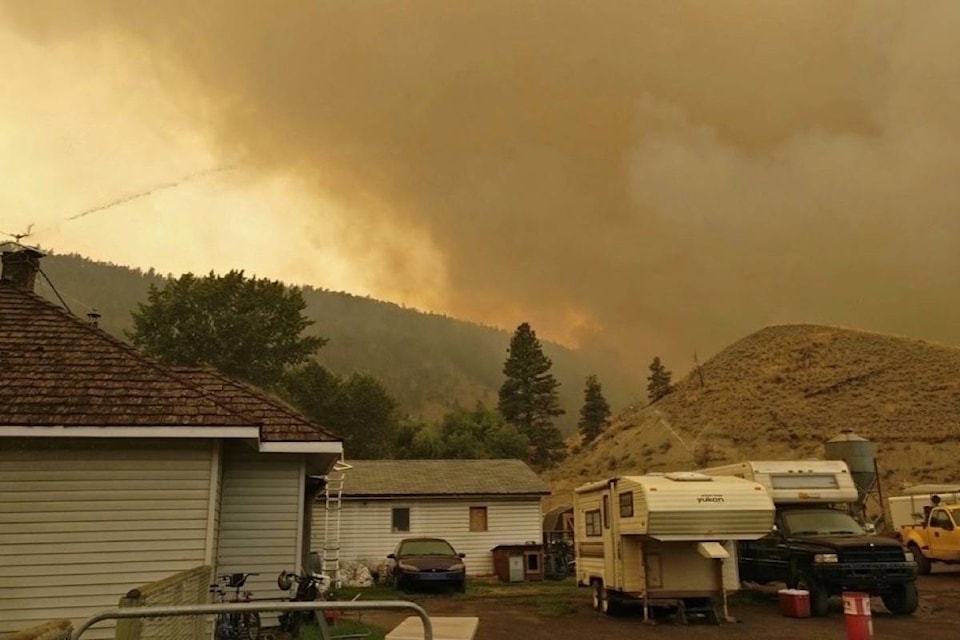Upset ranchers and other rural residents near Clinton are banding together to call for an apology and compensation from the B.C. government, after controlled burns on Hart Ridge Mountain south of Clinton went wrong and led to untold losses of livestock and property.
The affected residents are unhappy with orders given to light up the controlled burn on August 1 on the Hart Ridge Mountain near 20 Mile House during what they say were adverse wind conditions, which caused the fire to immediately jump Highway 97 and threaten nearby ranches and homes.
That fire rapidly expanded and moved south toward Highway 99 while travelling parallel to Highway 97, causing numerous evacuations and highway closures in a wide area.
They also say that the lives of rancher Greg Nyman and his entire herd of more than 100 cows were unnecessarily put at risk when Nyman was nearly caught by controlled burns on Hart Ridge while trying to move the cattle to safety earlier that day.
Nyman had been allowed by fire officials to get up in the highlands on the east side of Highway 97 before the burn to look for his cows. He was given three hours to search beginning at 9 a.m., but his search took longer than planned and he did not get out until almost 1:30 p.m. The fire ended up being set around him and the cows he was able to find, about 60 animals: half his herd.
Nyman was able to make it off the mountain safely, but he was forced to abandon his cows and does not know their fate.
“It just went unbelievably wrong,” he said. “The wind was blowing hard out of the northeast, and they were trying to burn to the northeast. I don’t know what kind of magic they thought was going to happen.
“They dropped these firebombs from a helicopter which, in high winds, is inherently wrong if you ask me. The fuel down there, the dryness level and the winds—it was a bad call.”
Nyman is quick to add that he does not blame the firefighters, saying “The front-line workers, they’re phenomenal, this is a management thing.”
Officials from the BC Wildfire Service said that the controlled burn crossing the highway was not part of the plan. During a media call on August 2, chief fire information officer Kevin Skrepnek said conditions appeared ideal until the winds shifted dramatically, blowing embers west across Highway 97.
Controlled burns are an essential and effective tool for fighting wildfires, and the BC Wildfire Service says that safety—of personnel, the public, equipment, and all adjacent values—is the primary concern. “Potential hazards must be identified, assessed, and mitigated with the ignition plan.”
Before controlled burns are carried out, environmental conditions such as weather, terrain, fuel loading, and potential fire behaviour are considered.
Wind, and its direction, is often the most influential environmental factor, with burns planned when wind direction will be the most beneficial to achieve the burn’s objectives.
Temperature and humidity must also be in a zone where ignition is successful and all fuel is consumed at a manageable rate. Controlled burns are always supported with appropriate resources, such as aircraft, heavy equipment, and firefighters.
Skrepnek says that while accidents do happen, the vast majority of planned burns are successful.
“We’ve been doing this on many fires across the province up until this point,” he said. “The fact of the matter is that when fires get to this size, the use of controlled ignitions is one of the best tactics that we have in terms of trying to contain them. Unfortunately, in this instance, the winds just weren’t in our favour.”
But Nyman said the decision-making in this case was very poor; the shift in wind direction was obvious before the fire was set, he insisted.
“I’m numb, I just can’t get my head around it,” he said. “Most of my cows are either burnt up or are going to die from their injuries.”
Fraser-Nicola MLA Jackie Tegart says that she has heard from people in the area regarding the strategies used in controlling the Elephant Hill fire, and will continue to try to take those concerns forward.
“I’ve talked to the BC Wildfire Service every morning, and said there are many questions regarding the back burn,” she told The Journal last week. “I talked to the incident commander, who is devastated that it didn’t work.
“Fire needs oxygen, heat, and fuel. There is no change in the forecast, so the only way to remove fuel is to burn it. At 20 Mile the wind shifted. They don’t always get it right.
“The BC Wildfire Service is doing everything it can to stop the forward movement of the fire on all flanks, and they’re the first ones to say that sometimes conditions change.
“And I know that safety is their top priority.”
Many of the area ranchers and residents are getting together through social media, and say they want to see an apology from government officials for the way Hart Ridge controlled burns were handled, and for a general lack of consultation with, and support for, local residents, which would allow protection of livestock and properties as much as possible before controlled burns are lit.
They are also calling for compensation for the livestock lost due to the wildfires, as well as for lost rural structures, woodlots, private timber, fields, grazing, and fencing.
The BC Wildfire Service has said that it is aware of the ranchers’ concerns, and that they may qualify for compensation.
In an email, a spokesperson for the service said that, under the Wildfire Act, “People can be compensated for damage on private land for avoidable damaged caused by fire control by government.
“With regard to the Elephant Hill fire, staff have already reached out to the residents.”
